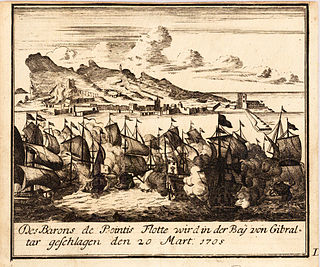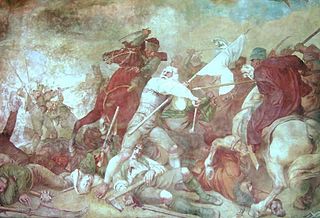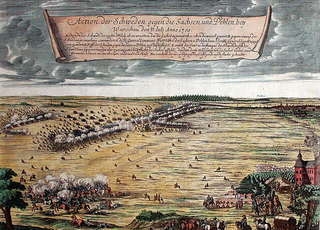 W
WThe Siege of Barcelona took place between 14 September and 19 October 1705 during the War of the Spanish Succession when a multinational Grand Alliance army led by Lord Peterborough, supporting the Habsburg pretender to the Spanish throne, captured the city of Barcelona from its Spanish Bourbonic defenders, most of whom then joined the Habsburg army.
 W
WThe Battle of Cabrita Point, sometimes referred to as the Battle of Marbella, was a naval battle that took place while a combined Spanish-French force besieged Gibraltar on 10 March 1705 during the War of Spanish Succession.
 W
WThe Battle of Cassano took place on 16 August 1705, during the War of the Spanish Succession. It was fought at the town of Cassano d'Adda, in Lombardy, Italy, between a French army commanded by the duc de Vendôme and an Imperial army under Prince Eugene of Savoy.
 W
WThe Battle of Muktsar or Battle of Khidrāne Dee Dhāb took place on 29 December 1705, following the siege of Anandpur. In 1704, Anandpur was under an extended siege by the allied forces of the Mughals and the hill chiefs.
 W
WThe Bavarian uprising of 1705–06 was a revolt against the occupation of the Electorate of Bavaria by the forces of the Austrian Habsburgs during the War of Spanish Succession (1701–14). It lasted from early November 1705 to 18 January 1706, approximately 75 days. Henric L. Wuermeling speaks of this as "the first revolution of modern history."
 W
WThe Campaign of Grodno was a plan developed by Johann Patkul and Otto Arnold von Paykull during the Swedish invasion of the Polish–Lithuanian Commonwealth, a part of the Great Northern War. Its purpose was to crush Charles XII's army with overwhelming force in a combined offensive of Russian and Saxon troops. The campaign, executed by Peter I of Russia and Augustus II of Saxony, began in July 1705 and lasted almost a year. In divided areas the allies would jointly strike the Swedish troops occupied in Poland, in order to neutralize the influence the Swedes had in the Polish politics. However, the Swedish forces under Charles XII successfully outmaneuvered the allies, installed a Polish king in favor of their own and finally won two decisive victories at Grodno and Fraustadt in 1706. This resulted in the Treaty of Altranstädt (1706) in which Augustus renounced his claims to the Polish throne, broke off his alliance with Russia, and established peace between Sweden and Saxony.
 W
WThe Battle of Gemauerthof was a battle in the Great Northern War, fought south of Riga near Jelgava, in present-day Latvia in July 1705. The Swedish forces under Adam Ludwig Lewenhaupt fought a Russian army under Boris Sheremetyev. The Swedes, exhausted after forced marching, went to camp and were cooking supper when the news came of a large Russian army with 16 artillery pieces nearby. The Swedes, who themselves had 17 artillery pieces quickly deployed into battle formation and, encouraged by General Lewenhaupt, attacked the Russians. Although suffering severe setbacks on their right flank, the assault continued. On the left, the Swedish cavalry charged and broke the Russians. The infantry in the centre fired carefully at point-blank range and then charged, pushing their foes back in disorder. The battle ended in a confused melee, which was eventually won by the Swedes. The Russian cavalry withdrew while the infantry was destroyed by a combined-arms assault leaving 5,000 men dead, wounded or captured. The Swedes were victorious, but the victory was only symbolic. In August, the Russians conquered Courland.
 W
WThe Twelfth Siege of Gibraltar was fought between September 1704 and May 1705 during the War of the Spanish Succession. It followed the capture in August 1704 of the fortified town of Gibraltar, at the southern tip of Spain, by an Anglo–Dutch naval force led by Sir George Rooke and Prince George of Hesse-Darmstadt. The members of the Grand Alliance, Holy Roman Empire, England, the Netherlands, Pro-Habsburg Spain, Portugal and the Savoy, had allied to prevent the unification of the French and Spanish thrones by supporting the claim of the Habsburg pretender Archduke Charles VI of Austria as Charles III of Spain. They were opposed by the rival claimant, the Bourbon Philip, Duke of Anjou, ruling as Philip V of Spain, and his patron and ally, Louis XIV of France. The war began in northern Europe and was largely contained there until 1703, when Portugal joined the confederate powers. From then, English naval attentions were focused on mounting a campaign in the Mediterranean to distract the French navy and disrupt French and Bourbon Spanish shipping or capture a port for use as a naval base. The capture of Gibraltar was the outcome of that initial stage of the Mediterranean campaign.
 W
WThe Battle of Praga took place on October 25, 1705 near the town of Warsaw, Poland during the fifth year of the Great Northern War. The Swedish army of more than 270 men assisted by approximately 140 soldiers from the Polish–Lithuanian Commonwealth under the command of Valentin Dahldorf defeated a combined Polish–Saxon–Russian force of about 5,000 men under Michał Serwacy Wiśniowiecki and Aleksandr Menshikov.
 W
WQueen Anne's War (1702–1713) was the second in a series of French and Indian Wars fought in England's Thirteen American Colonies during the reign of Anne, Queen of Great Britain. In Europe, it is generally viewed as the American theater of the War of the Spanish Succession; in the Americas, it is more commonly viewed as a standalone conflict. It is also known as the Third Indian War or as the Second Intercolonial War in France.
 W
WRákóczi's War of Independence (1703–11) was the first significant attempt to topple the rule of the Habsburgs over Hungary. The war was fought by a group of noblemen, wealthy and high-ranking progressives and was led by Francis II Rákóczi. The insurrection was unsuccessful, ending with the Treaty of Szatmár; however, the Hungarian nobility managed to partially satisfy Hungarian interests.
 W
WThe Revolutions of Tunis or the Muradid War of Succession was a period of troubles and civil wars in Ottoman Tunisia. It ran from the death of the Muradid sovereign Murad II Bey in 1675 until the seizure of power by the Husainid sovereign Al-Husayn I ibn Ali at-Turki in 1705. The belligerents were Ali Bey al-Muradi and Muhammad Bey al-Muradi, their uncle Muhammad al-Hafsi al-Muradi, several Deys of Tunis, the Turkish militia in Tunis and the Dey of Algiers.
 W
WThe Siege of St. John's was a failed attempt by French forces led by Daniel d'Auger de Subercase to take the fort at St. John's, Newfoundland during the winter months of 1705, in Queen Anne's War. Leading a mixed force of regulars, militia, and Indians, Subercase burned much of the town and laid an ineffectual siege against the fort for five weeks between late January and early March 1705. Subercase lifted the siege after running out of provisions and gunpowder.
 W
WSendling's Christmas (night) of murder was a massacre in 1705 in Sendling, 2 km south west of Munich. An army of peasants, protesting the Austrian regime during the Bavarian People's Uprising, had marched on Munich, but was betrayed from within and massacred. Some 1,100 peasants were killed.
 W
WThe Siege of Haguenau was a siege of the War of the Spanish Succession. An Imperial army under the command of Field Marshal Johann Karl von Thüngen, besieged and captured the French fortified city of Haguenau on the banks of the Rhine river in Alsace.
 W
WThe Siege of Zoutleeuw or the Siege of Léau was a siege of the War of the Spanish Succession. Allied troops with 16 artillery pieces under the command of the English Captain general the Duke of Marlborough, besieged and captured the small French-held Flemish fortified town of Zoutleeuw in the Spanish Netherlands.
 W
WThe Battle of Warsaw was fought on 31 July 1705 near Warsaw, Poland, during the Great Northern War. The battle was part of a power struggle for the Polish–Lithuanian throne. It was fought between Augustus II the Strong and Stanisław Leszczyński and their allies. Augustus II entered the Northern war as elector of Saxony and king of the Polish–Lithuanian Commonwealth, and had formed an alliance with Denmark–Norway and Russia. Stanisław Leszczyński had seized the Polish throne in 1704, with the support of the Swedish army of Charles XII of Sweden. The struggle for the throne forced the Polish nobility to pick sides; the Warsaw Confederation supported Leszczyński and Sweden, and the Sandomierz Confederation supported Augustus II and his allies. The conflict resulted in the Polish civil war of 1704–1706.
 W
WBattle of Zsibó was fought on November 15, 1705 between the Kuruc (Hungarian) army and forces of the Habsburg Empire, Kingdom of Denmark and Vojvodian Serbs in Zsibó, Principality of Transylvania. The Austrian marshal Ludwig Herbeville marched against Transylvania. Although the Kuruc-French army was equal in size to the combined Austrian, Danish and Serbian forces, Francis II Rákóczi went on the defense due to the inferior training of his troops. The Danes and Austrians launched a powerful attack on the French and Kuruc infantry. Although the Kuruc infantry held its ground, the Kuruc cavalry could not launch an attack due to a lack of leadership and an overly muddy battlefield. The Austrian cavalry was thus capable of flanking the Hungarians on the left, forcing the Hungarians to retreat and crushing their cavalry in the process. After the battle, the combined Austrian-Danish army bought Transylvania.